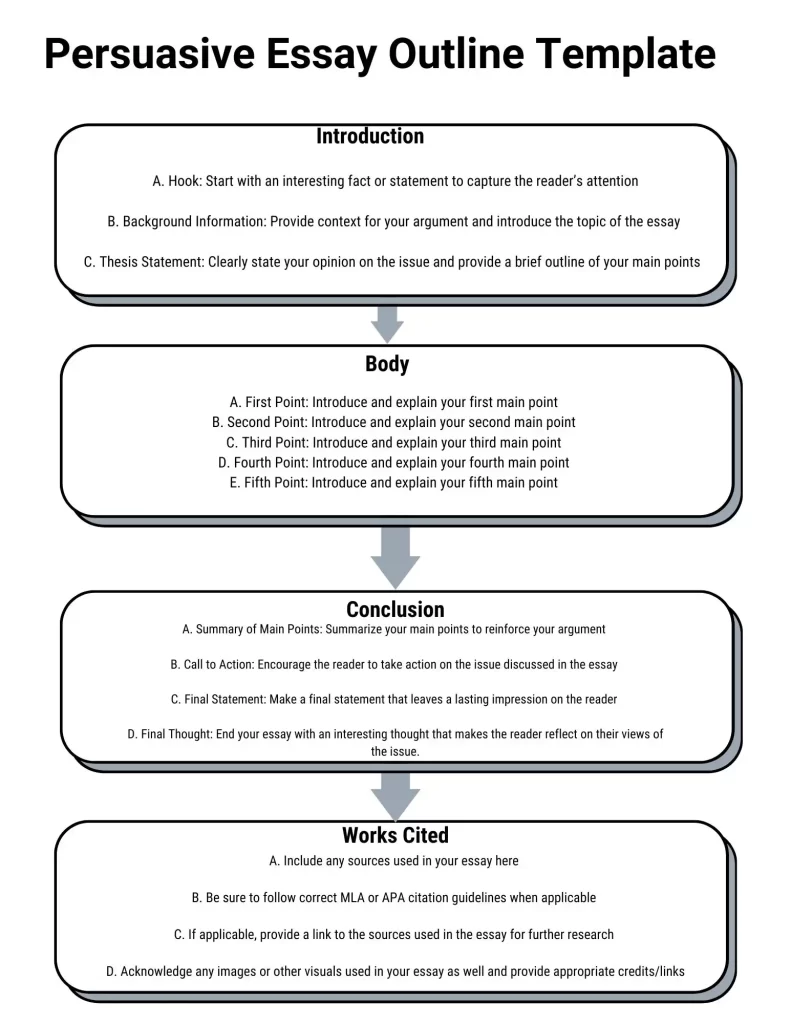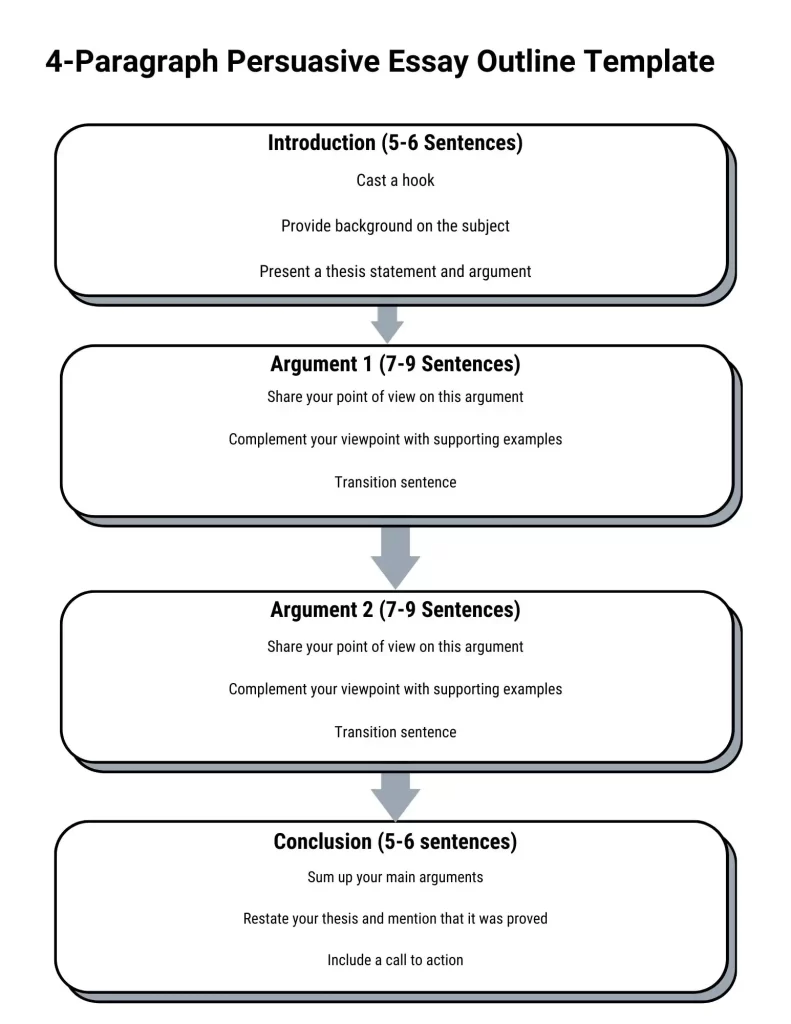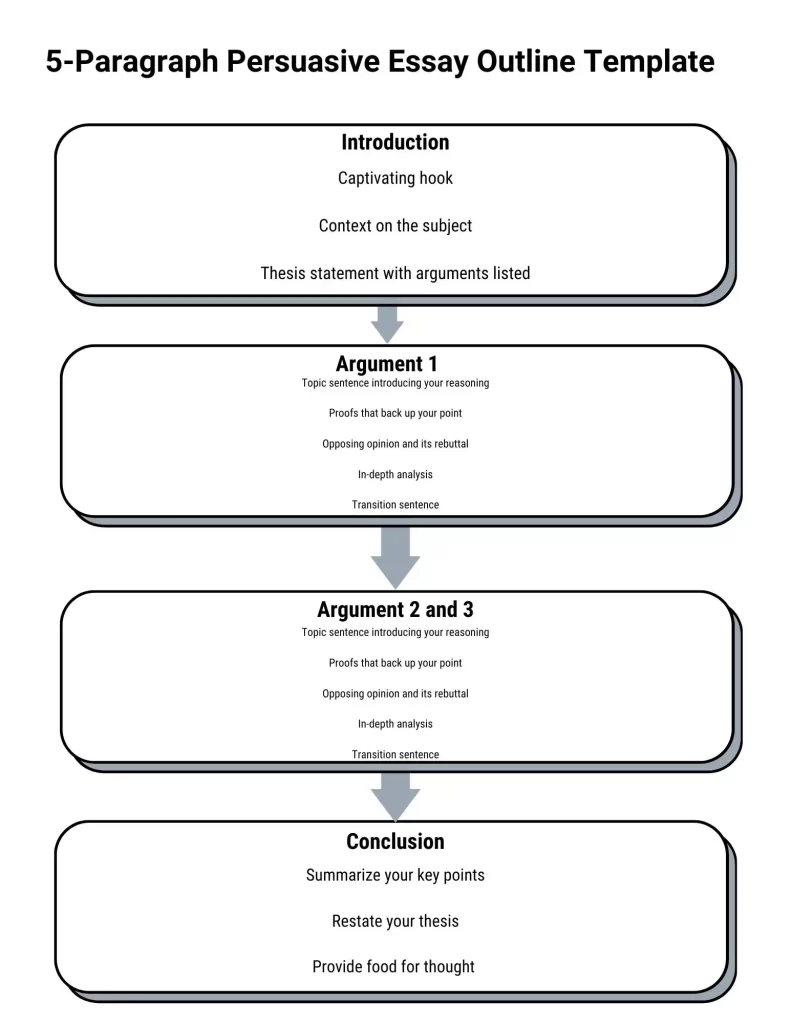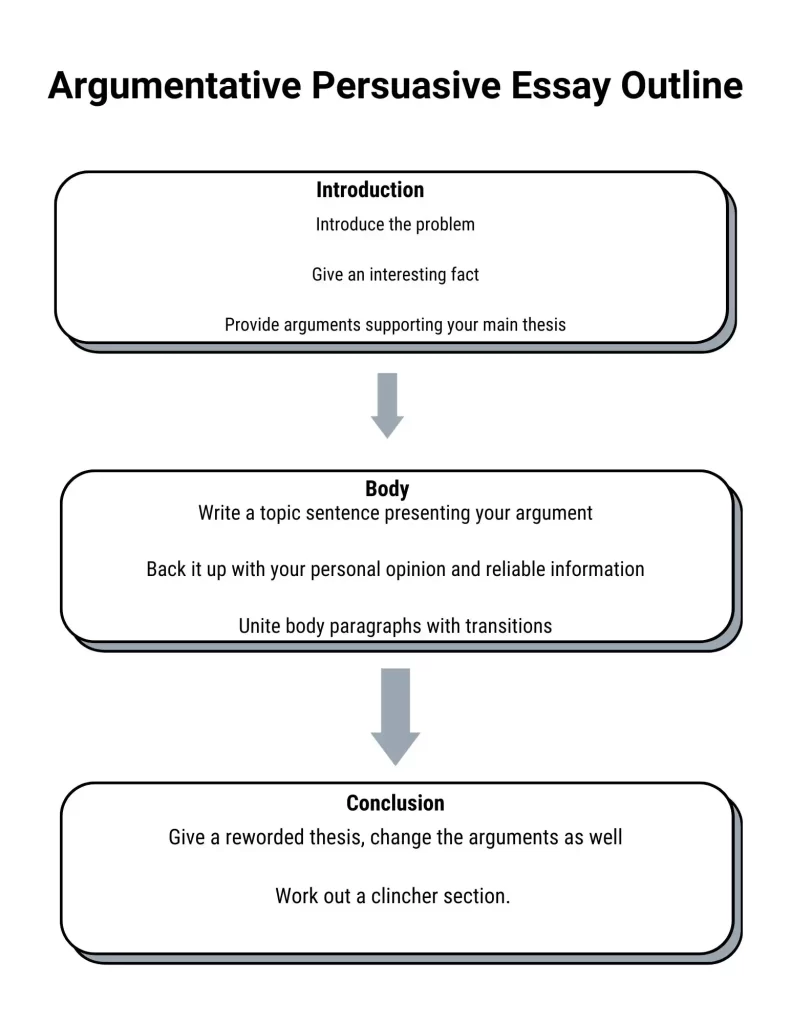Crafting an Outstanding Persuasive Essay Outline
Crafting an essay can be challenging for many, but knowing the right format and structure can simplify the writing process considerably. One of the most effective types of essays is the persuasive essay, designed to convince the reader of a certain viewpoint. The backbone of a persuasive essay is its outline.
This article will delve deep into how to write a compelling persuasive essay outline for your essay.
Writing a Persuasive Essay Outline
Are you embarking on writing a persuasive essay and feeling uncertain about the starting point? Crafting an outline beforehand can be immensely beneficial.
Such an outline serves as a guiding blueprint for your essay, ensuring your thoughts flow coherently. Additionally, it aids in identifying the extent of research required and pinpointing the relevant evidence to incorporate into your essay.
What is a Persuasive Essay Outline?
A persuasive essay outline is a plan that structures the main points and arguments of the essay in a logical sequence. It helps organize thoughts, ensure that the writer remains on track, and effectively communicates their point of view.
Persuasive Essay Format
When getting ready to write a persuasive essay, it’s essential to have a clear plan. This plan helps ensure your points are presented in an organized and effective way. Each element can make your essay clearer and more readable, from the font style to the spacing between lines. Here are the basics of writing your persuasive essay to ensure your argument and evidence shine through clearly.
- Font: Use a readable font, preferably Times New Roman or Arial, in 12-point size.
- Spacing: Double spacing is recommended for clarity.
- Alignment: Left-align the text.
- Word count: Depending on your assignment, persuasive essays typically range from 500-1500 words.
How to Write Persuasive Essay Outline
Creating a persuasive essay outline means coherently organizing your arguments to convince your readers. To achieve this, it’s crucial to use a detailed outline. This effective persuasive essay structure usually consists of three primary components:
- Introduction
- Body
- Conclusion
Persuasive Essay Introduction
The introductory paragraph of a persuasive essay and plays a crucial role in capturing the reader’s attention and setting the tone for the rest of the piece. The starting point entices the reader to continue and sets the stage for your argument.
To start your essay on the right note, it’s essential to pay attention to the following crucial elements:
- Know Your Topic: The foundation lies in truly understanding your chosen essay topic. This means diving deep into research, studying various aspects of the issue, and forming a comprehensive view. A well-understood topic not only lends credibility to your arguments but also ensures that you can address counterarguments effectively.
- Start with an Interesting Hook Statement: This is the very first sentence; its purpose is to grab the reader’s attention. It could be a surprising fact, a provocative question, or a bold statement related to your topic. After the hook, provide some background about the topic you’re discussing. This helps the reader understand the context and why the issue is important.
- Know Your Audience: Understanding your audience is fundamental in any writing, especially in persuasive essays. Recognizing who you’re writing for allows you to shape your message in a way that resonates most effectively. You can craft arguments that appeal directly to their beliefs and emotions by grasping your readers’ backgrounds, values, and interests. This personalized approach can make your essay more influential and engaging.
- State the Thesis Statement: The thesis statement is your essay’s central idea or argument, encapsulated in one or two sentences. It serves as a guidepost, indicating the direction your essay will take. A well-crafted thesis doesn’t just state a fact but declares a stance on an issue, challenging readers and encouraging them to continue reading to understand your perspective.
Persuasive Essay Body Paragraphs
The body of a persuasive essay is where you present the bulk of your argument. It is the space where you elaborate on your points, back them up with evidence, and drive home the relevance of your stance.
It’s crucial to follow some key guidelines to make this section effective.
- Explain Your Main Idea: Every paragraph in the body should revolve around a main idea, often introduced at the beginning via a topic sentence. This sentence sets the tone and direction for the rest of the paragraph. It’s essential that this main idea ties back to your thesis statement and contributes to building your overall argument.
- Support Your Perspective: Once you’ve presented your main idea, you must support it with relevant evidence. This could be in the form of statistics, quotations from experts, examples, or any factual information substantiating your point. This evidence shouldn’t just be presented; you should also explain its relevance and support of your argument. Remember, it’s not just about presenting facts; it’s about convincing your reader of your perspective.
- Transition Words: For your essay to flow smoothly, you need to link your ideas and paragraphs seamlessly. This is where transition words come in. Words and phrases like “furthermore,” “in addition,” “however,” and “on the other hand” help guide the reader through your argument, indicating relationships between points and ensuring your essay has a logical progression.
- Concluding Sentences: Each body paragraph should ideally end with a concluding sentence. This sentence wraps up the paragraph, reiterating the importance of the main idea and its role in the larger argument. It also prepares the reader for the next paragraph and the points you’re about to discuss.
How to Write a Conclusion for a Persuasive Essay
Writing the best persuasive essay conclusion is critical as it provides the final impression on the reader and reinforces your overall argument. The conclusion should not merely restate what has been discussed but should provide closure, leaving the reader convinced or at least seriously considering your perspective.
- Revisit the Thesis: Start by revisiting your thesis statement. However, instead of merely repeating it, rephrase it in a way that shows its importance based on the evidence and arguments you’ve presented throughout your essay. This reminds the reader of the primary focus of your argument and the reason for your stance.
- Summarize Key Points: Briefly recap the main points you’ve made in your essay. This doesn’t mean listing them individually but synthesizing them to show how they collectively support your thesis. It’s a way to show the reader that your argument is robust and well-structured.
- Leave a Lasting Impression: Consider ending with a powerful statement or a thought-provoking question that reinforces your argument and sticks with the reader. This could be a call to action, a prediction, or a rhetorical question highlighting your topic’s relevance and importance.
- Tie Back to the Introduction: If you started your essay with an anecdote, fact, or provocative question, you could refer back to it in the conclusion, providing a sense of closure and cohesion.
- Avoid Introducing New Information: The essay conclusion is not the place to introduce new arguments or evidence. Its primary purpose is to wrap up your existing arguments and provide a strong ending to your essay.
Persuasive Essay Outline Template
The persuasive essay outline template is a roadmap that guides writers in organizing their thoughts, presenting their arguments logically, and ensuring the essay flows seamlessly from one point to the next. By adhering to this template, writers can ensure their essay is convincing and easy for readers to follow and understand.

4-Paragraph Persuasive Essay Outline Template
The 4-paragraph persuasive essay outline template is a streamlined approach, perfect for conveying a focused and succinct argument. This format breaks down the essay into four distinct sections, each with a specific purpose, ensuring that the central point is presented, supported, and concluded concisely.
Ideal for topics requiring a straightforward discussion, this template is a great starting point for those new to persuasive writing or assignments with a tighter word count.

5-Paragraph Persuasive Essay Outline Template
The 5-paragraph persuasive essay outline template offers a balanced approach, allowing the writer to present an argument, support it adequately, and wrap it up conclusively, all within a reasonably concise space.
By dividing the essay into five sections, this template ensures that every crucial element of a persuasive argument is addressed, making it an excellent choice for both budding writers and seasoned professionals.

Argumentative Persuasive Essay Outline
The argumentative essay outline goes beyond merely persuading readers; it seeks to present an argument based on evidence, pushing the readers to reconsider their stance and potentially align with the writer’s viewpoint. This format emphasizes not only the writer’s perspective but also acknowledges opposing views, addressing them head-on.
By using this outline, writers can systematically construct their argument, provide substantial evidence, and engage readers in a deeper, more critical discussion on the topic at hand.

Persuasive Essay Example Outline
Here is a high-quality persuasive essay example to help you craft essays that captivate your readers and persuade them to see things from a new perspective.
The Importance of Nurse-to-Patient Ratios in Enhancing Quality of Care I. Introduction Hook: Anecdote about a nurse overwhelmed with too many patients. Brief Background: Current nurse-to-patient ratios in various settings. Thesis Statement: Proper nurse-to-patient ratios are vital for maintaining the quality of care, ensuring patient safety, and preventing burnout among nursing professionals. II. Body Paragraph 1: Impact of Nurse-to-Patient Ratios on Quality of Care Topic Sentence: Higher nurse-to-patient ratios directly correlate with enhanced patient outcomes. Evidence: Studies showcasing decreased mortality rates with better ratios. Real-life examples of hospitals that improved patient outcomes after adjusting ratios. Analysis: Explanation of why having more nurses available for individualized care leads to better patient recovery and overall health. III. Body Paragraph 2: Patient Safety and Nurse-to-Patient Ratios Topic Sentence: A lower nurse-to-patient ratio significantly reduces the risk of medical errors and patient complications. Evidence: Statistics on medical errors based on staffing. Testimonies from nurses on how workload impacts the safety protocols they follow. Analysis: Discussion on how nurses, when overwhelmed, might inadvertently overlook details leading to potential risks. IV. Body Paragraph 3: Nurse Burnout and Its Connection to Patient Ratios Topic Sentence: Adequate nurse-to-patient ratios are essential in preventing burnout and job dissatisfaction among nurses. Evidence: Studies linking high patient loads to increased stress and burnout rates among nurses. Personal accounts from nurses discussing the emotional and physical toll of handling too many patients. Analysis: Examination of the long-term impacts of burnout on the nursing profession, including high turnover rates and its effect on patient care. V. Conclusion Restate Thesis: Reiterate the significance of proper nurse-to-patient ratios. Summarize Main Points: Briefly recap the benefits of maintaining appropriate ratios. Call to Action: Encourage readers to advocate for legislative changes or hospital policies prioritizing nurse staffing ratios.
This clear outline provides a structure that can be filled in with specific details, studies, and references to create a comprehensive and convincing essay on the importance of nurse-to-patient ratios in nursing.
Creating an Outline for a Persuasive Essay: Final Thoughts
Creating a solid persuasive essay outline is the first step towards crafting a compelling argument for a persuasive speech or essay. It serves as a roadmap, guiding you from the introduction to the conclusion. With clarity, organization, and a deep understanding of your persuasive essay topics, you’re on your way to convincing your readers effectively.
Master the art of persuasion with a top-notch persuasive essay outline! Our nursing essay writers are here to help you craft a compelling roadmap for your essay. Click here to order now and watch your persuasive essay take shape with precision and impact.